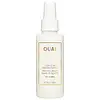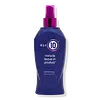What's inside
What's inside
 Key Ingredients
Key Ingredients

 Benefits
Benefits

 Concerns
Concerns

 Ingredients Side-by-side
Ingredients Side-by-side

Water
Skin ConditioningCyclopentasiloxane
EmollientCetearyl Alcohol
EmollientParfum
MaskingQuaternium-91
Phenoxyethanol
PreservativeBrassica Campestris/Aleurites Fordi Oil Copolymer
Skin ConditioningCetrimonium Chloride
AntimicrobialDipropylene Glycol
HumectantGlycerin
HumectantMyristyl Myristate
EmollientPolysilicone-29
Behentrimonium Chloride
PreservativeBenzyl Salicylate
PerfumingSilicone Quaternium-16
Skin ConditioningLimonene
PerfumingLinalool
PerfumingUndeceth-11
EmollientCoumarin
PerfumingHydroxycitronellal
PerfumingGuar Hydroxypropyltrimonium Chloride
Skin ConditioningButyloctanol
HumectantUndeceth-5
Emulsifying3-O-Ethyl Ascorbic Acid
Skin ConditioningAdansonia Digitata Seed Oil
EmollientArgania Spinosa Kernel Oil
EmollientDisodium EDTA
Oenothera Biennis Oil
EmollientTocopheryl Acetate
AntioxidantCitric Acid
BufferingGlycolic Acid
BufferingLeuconostoc/Radish Root Ferment Filtrate
AntimicrobialPanthenol
Skin ConditioningButylene Glycol
HumectantSodium Hydroxide
BufferingTamarindus Indica Extract
SmoothingSodium PCA
HumectantSodium Lactate
BufferingAcetic Acid
BufferingArginine
MaskingCetearamidoethyldiethonium Succinoyl Hydrolyzed Pea Protein
CleansingAspartic Acid
MaskingTocopherol
AntioxidantPCA
HumectantBHT
AntioxidantIodopropynyl Butylcarbamate
PreservativeIsopropyl Alcohol
SolventGlycine
BufferingAlanine
MaskingSodium Hyaluronate
HumectantSerine
MaskingValine
MaskingHydrolyzed Rhodophyceae Extract
Isoleucine
Skin ConditioningProline
Skin ConditioningThreonine
Histidine
HumectantPhenylalanine
MaskingWater, Cyclopentasiloxane, Cetearyl Alcohol, Parfum, Quaternium-91, Phenoxyethanol, Brassica Campestris/Aleurites Fordi Oil Copolymer, Cetrimonium Chloride, Dipropylene Glycol, Glycerin, Myristyl Myristate, Polysilicone-29, Behentrimonium Chloride, Benzyl Salicylate, Silicone Quaternium-16, Limonene, Linalool, Undeceth-11, Coumarin, Hydroxycitronellal, Guar Hydroxypropyltrimonium Chloride, Butyloctanol, Undeceth-5, 3-O-Ethyl Ascorbic Acid, Adansonia Digitata Seed Oil, Argania Spinosa Kernel Oil, Disodium EDTA, Oenothera Biennis Oil, Tocopheryl Acetate, Citric Acid, Glycolic Acid, Leuconostoc/Radish Root Ferment Filtrate, Panthenol, Butylene Glycol, Sodium Hydroxide, Tamarindus Indica Extract, Sodium PCA, Sodium Lactate, Acetic Acid, Arginine, Cetearamidoethyldiethonium Succinoyl Hydrolyzed Pea Protein, Aspartic Acid, Tocopherol, PCA, BHT, Iodopropynyl Butylcarbamate, Isopropyl Alcohol, Glycine, Alanine, Sodium Hyaluronate, Serine, Valine, Hydrolyzed Rhodophyceae Extract, Isoleucine, Proline, Threonine, Histidine, Phenylalanine
Water
Skin ConditioningPropylene Glycol
HumectantCetearyl Alcohol
EmollientCyclopentasiloxane
EmollientBehentrimonium Chloride
PreservativePanthenol
Skin ConditioningSilk Amino Acids
HumectantAloe Barbadensis Leaf Juice
Skin ConditioningCamellia Sinensis Leaf Extract
AntimicrobialHelianthus Annuus Seed Extract
Skin ConditioningQuaternium-80
Butylene Glycol
HumectantPhenoxyethanol
PreservativeMethylparaben
PreservativePropylparaben
PreservativeEthylparaben
PreservativeParfum
MaskingCitronellol
PerfumingHexyl Cinnamal
PerfumingLimonene
PerfumingLinalool
PerfumingWater, Propylene Glycol, Cetearyl Alcohol, Cyclopentasiloxane, Behentrimonium Chloride, Panthenol, Silk Amino Acids, Aloe Barbadensis Leaf Juice, Camellia Sinensis Leaf Extract, Helianthus Annuus Seed Extract, Quaternium-80, Butylene Glycol, Phenoxyethanol, Methylparaben, Propylparaben, Ethylparaben, Parfum, Citronellol, Hexyl Cinnamal, Limonene, Linalool
 Reviews
Reviews

Ingredients Explained
These ingredients are found in both products.
Ingredients higher up in an ingredient list are typically present in a larger amount.
This ingredient is a preservative and often used for it's anti-static properties. You'll most likely see this ingredient in hair conditioners.
It does not cause irritation or sensitization in leave-on products at 1-5%.
Butylene Glycol (or BG) is used within cosmetic products for a few different reasons:
Overall, Butylene Glycol is a safe and well-rounded ingredient that works well with other ingredients.
Though this ingredient works well with most skin types, some people with sensitive skin may experience a reaction such as allergic rashes, closed comedones, or itchiness.
Learn more about Butylene GlycolCetearyl alcohol is a mixture of two fatty alcohols: cetyl alcohol and stearyl alcohol. It is mainly used as an emulsifier. Emulsifiers help prevent the separation of oils and products. Due to its composition, it can also be used to thicken a product or help create foam.
Cetearyl alcohol is an emollient. Emollients help soothe and hydrate the skin by trapping moisture.
Studies show Cetearyl alcohol is non-toxic and non-irritating. The FDA allows products labeled "alcohol-free" to have fatty alcohols.
This ingredient is usually derived from plant oils such as palm, vegetable, or coconut oils. There is debate on whether this ingredient will cause acne.
Due to the fatty acid base, this ingredient may not be Malassezia folliculitis safe.
Learn more about Cetearyl AlcoholCyclopentasiloxane, or D5, is a silicone used to improve texture of products and trap moisture.
D5 is considered lightweight and volatile. Volatile means it evaporates quickly after application. Once evaporated, D5 leaves a thin barrier that helps keep skin hydrated.
It is also an emollient. Emollients help soften the skin and prevent water loss. Silicones create a silky texture in products. D5 helps other ingredients become more spreadable.
Studies show D5 is safe to use in skincare products. We recommend speaking with a skincare professional if you have concerns.
Learn more about CyclopentasiloxaneLimonene is a fragrance that adds scent and taste to a formulation.
It's found in the peel oil of citrus fruits and other plants such as lavender and eucalyptus. The scent of limonene is generally described as "sweet citrus".
Limonene acts as an antioxidant, meaning it helps neutralize free radicals.
When exposed to air, oxidized limonene may sensitize the skin. Because of this, limonene is often avoided by people with sensitive skin.
The term 'fragrance' is not regulated in many countries. In many cases, it is up to the brand to define this term. For instance, many brands choose to label themselves as "fragrance-free" because they are not using synthetic fragrances. However, their products may still contain ingredients such as essential oils that are considered a fragrance.
Learn more about LimoneneLinalool is a fragrance and helps add scent to products. It's derived from common plants such as cinnamon, mint, citrus, and lavender.
Like Limonene, this ingredient oxidizes when exposed to air. Oxidized linalool can cause allergies and skin sensitivity.
This ingredient has a scent that is floral, spicy tropical, and citrus-like.
Learn more about LinaloolPanthenol is a common ingredient that helps hydrate and soothe the skin. It is found naturally in our skin and hair.
There are two forms of panthenol: D and L.
D-panthenol is also known as dexpanthenol. Most cosmetics use dexpanthenol or a mixture of D and L-panthenol.
Panthenol is famous due to its ability to go deeper into the skin's layers. Using this ingredient has numerous pros (and no cons):
Like hyaluronic acid, panthenol is a humectant. Humectants are able to bind and hold large amounts of water to keep skin hydrated.
This ingredient works well for wound healing. It works by increasing tissue in the wound and helps close open wounds.
Once oxidized, panthenol converts to pantothenic acid. Panthothenic acid is found in all living cells.
This ingredient is also referred to as pro-vitamin B5.
Learn more about PanthenolParfum is a catch-all term for an ingredient or more that is used to give a scent to products.
Also called "fragrance", this ingredient can be a blend of hundreds of chemicals or plant oils. This means every product with "fragrance" or "parfum" in the ingredients list is a different mixture.
For instance, Habanolide is a proprietary trade name for a specific aroma chemical. When used as a fragrance ingredient in cosmetics, most aroma chemicals fall under the broad labeling category of “FRAGRANCE” or “PARFUM” according to EU and US regulations.
The term 'parfum' or 'fragrance' is not regulated in many countries. In many cases, it is up to the brand to define this term.
For instance, many brands choose to label themselves as "fragrance-free" because they are not using synthetic fragrances. However, their products may still contain ingredients such as essential oils that are considered a fragrance by INCI standards.
One example is Calendula flower extract. Calendula is an essential oil that still imparts a scent or 'fragrance'.
Depending on the blend, the ingredients in the mixture can cause allergies and sensitivities on the skin. Some ingredients that are known EU allergens include linalool and citronellol.
Parfum can also be used to mask or cover an unpleasant scent.
The bottom line is: not all fragrances/parfum/ingredients are created equally. If you are worried about fragrances, we recommend taking a closer look at an ingredient. And of course, we always recommend speaking with a professional.
Learn more about ParfumPhenoxyethanol is a preservative that has germicide, antimicrobial, and aromatic properties. Studies show that phenoxyethanol can prevent microbial growth. By itself, it has a scent that is similar to that of a rose.
It's often used in formulations along with Caprylyl Glycol to preserve the shelf life of products.
Water. It's the most common cosmetic ingredient of all. You'll usually see it at the top of ingredient lists, meaning that it makes up the largest part of the product.
So why is it so popular? Water most often acts as a solvent - this means that it helps dissolve other ingredients into the formulation.
You'll also recognize water as that liquid we all need to stay alive. If you see this, drink a glass of water. Stay hydrated!
Learn more about Water